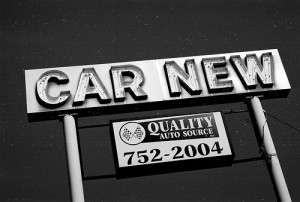 Nothing like a new car. Right? After all…it is – new! It drives like new, it has the new car smell and you are the very original owner. But there are times when a new car is exactly what you don’t need. Here are three:
Nothing like a new car. Right? After all…it is – new! It drives like new, it has the new car smell and you are the very original owner. But there are times when a new car is exactly what you don’t need. Here are three:
1. For high mileage driving
I realize that a nice, comfortable vehicle is needed when one spends much of each day in it. However, purchasing a new vehicle just to rack up miles on doesn’t make sense because you are, in effect, destroying it.
For example, a new Honda Accord LX-S Coupe (a vehicle I chose at random) would, according to KBB, cost $22,177. Driving it 100,000 miles in three years will lower its value (private party sale) to $9,445, a loss in value of $0.127 per mile.
On the other hand, the same vehicle, at three years old and with 30,000 miles already on it, would cost $13,620 miles and sell for $6,625 three years later after you have put 100,000 miles it. Your cost per mile for this choice is only $0.07… a 45% savings.
For this scenario comparison, you would be saving $158 a month. Yes, I realize that you will have slightly more maintenance expenses when you buy used, but your savings should be at least $140 a month when factoring in maintenance.
As may be expected, the cost (and savings) for a premium vehicle is more. The same comparison for a Cadillac Escalade EXT instead of the Honda Accord reveals a savings of $297 a month (before allowing for additional maintenance expenses) when buying used instead of new.
You get the point. If you are going to destroy a vehicle with high mileage driving, you will be dollars ahead with a used vehicle instead of a new one. One more thought here: if you are going to drive a vehicle high miles, consider trying for 200,000 miles as I explain in this post: Change Your Mindset and Save a Fortune: 200,000 Miles is the New 100,000 Miles.
2. For a construction related work vehicle.
Whether you are in the heating/cooling business, home remodeling business or farming business, the key word here is “work”. Buying a new truck to throw tools into, carry compressors in or just park near a construction site is an invitation for dings, scratches and other abuse. A functional “pre-scratched” truck will serve you just as well without the new price tag.
3. For any vehicle you can’t pay cash for.
“But”, you say, “I will always have car payments. Everyone does.”
Wrong. Everyone doesn’t and you don’t have to. I realize it isn’t easy to break long term habits, but you can do it. How? By continuing to drive your car after it is paid for and making those payments to yourself…payments that can grow even greater when you practice hypermiling (learn all about hypermiling by reading “What is hypermiling?”) As you build that savings account and consider paying cash for your next car, you will discover something: you are much more selective about buying a car when you pay for it with saved money than you are with borrowed money. Why? Because signing loan papers is not nearly as traumatic as withdrawing that hard earned money from your account. You will find yourself stretching more life from your cars, paying less when you buy and loving the fact that you never have car payments.
Summary
A vehicle is probably the biggest depreciating asset most of us will ever own. Without realizing it, many people jeopardize their family’s finances by placing a disproportionate amount of their income into these assets. Buying new vehicles for high mileage driving, for construction related work or any time you can’t pay cash are three examples of new car purchases to steer away from.
photo credit: Steve Snodgrass

Leave a Reply